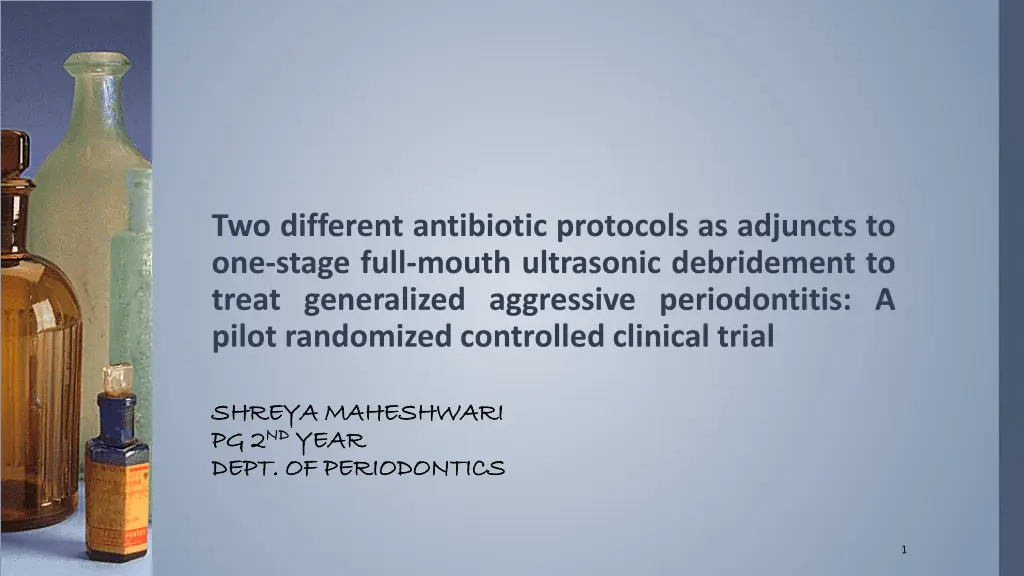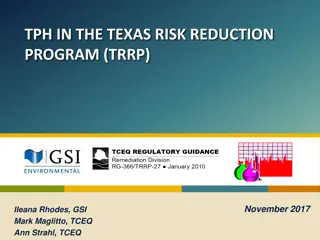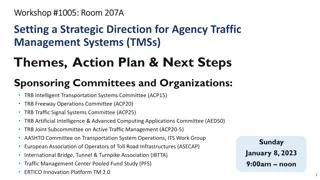
Antibiotic Protocols for Aggressive Periodontitis Treatment
Explore the efficacy of two antibiotic protocols as adjuncts to one-stage full-mouth ultrasonic debridement in treating generalized aggressive periodontitis through a pilot randomized controlled clinical trial. Learn about the unique characteristics of aggressive periodontitis and the historical evolution of its classification. Published in the Journal of Periodontology in February 2019.
Download Presentation

Please find below an Image/Link to download the presentation.
The content on the website is provided AS IS for your information and personal use only. It may not be sold, licensed, or shared on other websites without obtaining consent from the author. If you encounter any issues during the download, it is possible that the publisher has removed the file from their server.
You are allowed to download the files provided on this website for personal or commercial use, subject to the condition that they are used lawfully. All files are the property of their respective owners.
The content on the website is provided AS IS for your information and personal use only. It may not be sold, licensed, or shared on other websites without obtaining consent from the author.
E N D
Presentation Transcript
Two different antibiotic protocols as adjuncts to one-stage full-mouth ultrasonic debridement to treat generalized aggressive periodontitis: A pilot randomized controlled clinical trial SHREYA SHREYA MAHESHWARI MAHESHWARI PG PG 2 2ND YEAR DEPT DEPT. . OF OF PERIODONTICS PERIODONTICS NDYEAR 1
PROLOGUE AGGRESSIVE PERIODONTITIS a disease of the periodontium occurring in an otherwise healthy adolescent which is characterized by a rapid loss of alveolar bone about more than one tooth of the permanent dentition. The amount of destruction manifested is not commensurate with the amount of local irritants. Baer, 1971 3
1923 Gottlieb H I S T O R Y called diffuse atrophy of the alveolar bone. 1999, World Workshop in Periodontics several rapidly progressing periodontitis forms were united under the term aggressive periodontitis. 1928 Gottlieb He then termed the disease deep cementopathia and hypothesized that this was a disease of eruption and that cementum initiated a foreign body response. 1938 Wannenmacher The European Federation of Periodontology and the American Academy of Periodontology for November 2017 grouped chronic and aggressive periodontitis under the same category, periodontitis , and established a staging and grading scheme. described incisor first molar involvement and called the disease parodontitis marginalis progressiva 1966, the World Workshop in Periodontics concluded that the concept of periodontosis as a degenerative entity was unsubstantiated and that the term should be eliminated from periodontal nomenclature 4
Aggressive Periodontitis The following characteristics are common to patients with aggressive periodontitis: Otherwise clinically healthy patient (note the distinction with periodontitis as a manifestation of systemic disease) Rapid attachment loss and bone destruction Familial aggregation of diseased individuals The following characteristics are common but not universal: Amount of microbial deposits inconsistent with disease severity Increased levels of Actinobacillus actinomycetemcomitans Abnormalities in phagocyte function Hyper-responsive macrophages, producing increased prostaglandin E2 (PGE2) and interleukin-1 (IL-1) In some cases, self-arresting disease progression 5
SOURCE OF THE ARTICLE Name of Journal: Journal of Periodontology Year : 2019 Month : february Page numbers : 1-10 Volume 89 Issue 10 Section of the journal under which the article is published : Original Research Accepted for publication February 2019. 7
ABOUT THE JOURNAL The aim of journal of periodontology is to publish original papers of the highest scientific quality to support the practice, education, & research in the dental speciality of periodontics. 8
METRICS OF THE ARTICLE Current impact factor - 3.392 5-year impact - 2.90 Cited half-life - 9.20 Immediacy index - 0.32 Eigen factor - 0.02 Article influence - 0.83 9
ISSN : 0022-3492 (Print) 1943-3670 (Electronic) 0022-3492 (Linking) OCLC no. : 2105859 NLM ID : 8000345 [Serial] Other ID : (DNLM)J34160000(s) (0CoLC)02105859 Publisher : American academy of periodontology 10
NLM Title Abbreviation : J Periodontol ISO Abbreviation : J Periodontol Editor-in-Chief : Kenneth S. Kornman, DDS PhD Waltham, Massachusetts Associate Editors : Anna Dongari Thomas W David W 11
Publication Start Year: 2018 Frequency: Monthly Publication Type: Journals Country of Publication: United States Publisher: (Chicago) American academy of periodontology- Latest Publisher: American academy of periodontology- Michigan Ave Acid-Free: No Current Indexing Status: Currently indexed for MEDLINE 12
TITLE Two different antibiotic protocols as adjuncts to one-stage full-mouth ultrasonic debridement to treat generalized aggressive periodontitis: A pilot randomized controlled clinical trial 13
AUTHORS Division of Periodontics, Institute of Science and Technology, S o Paulo State University, S o Paulo, Brazil Department of Prosthodontics and Periodontics, Division of Periodontics, University of Campinas ,Brazil C ssia F. Araujo Aur lio A. Reis Naira M.R.B. Andere Renato C.V. Casarin N dia C. Castro dos Santos Ingrid F. Mathias- Santamaria Luciane D. de Oliveira Maria A.N. Jardini Mauro P. Santamaria 14
INTRODUCTION The initial treatment of this disease aims to disrupt the biofilm and reduce the bacterial load of periodontal pockets by root instrumentation using hand-driven or power-driven instruments. However, the use of adjunctive antimicrobial agents is usually required in the treatment of generalized aggressive periodontitis (GAgP). Due to the capability of disease-related pathogens, mostly Aggregatibacter actinomycetemcomitans and Porphyromonas gingivalis, to attach to periodontal pocket epithelium, invade the periodontal connective tissue, and thereby escape from host defenses. 15
Effectiveness of the amoxicillin (AMX) and metronidazole (MET) combination. This association promotes greater gain in the clinical attachment level (CAL), as well as greater reduction in periodontopathogenic microorganisms and in the levels of inflammatory cytokines when compared with mechanical treatment alone. Hypersensibility reaction to AMX, requiring another drug. CLM, has its higher concentration in inflamed gingival tissue when compared with health. It may reach increased concentration levels in gingiva than in plasma and accumulate within fibroblasts and epithelial cells. These characteristics may favor its action on intracellular microorganisms that can invade periodontal tissue and may facilitate the elimination of pathogens. CLM may enhance the treatment outcomes of AgP. 16
AIM To assess the clinical and microbiological responses of the AMX + MET association versus CLM combined with one-stage full-mouth ultrasonic debridement (FMUD) in the treatment of patients with GAgP. 17
1) were pregnant or nursing; 2) were suffering from any other systemic disease (e.g., cardiovascular, diabetes, blood dyscrasias, immunodeficiency, etc.); 1) diagnosis of GAgP, 2) presence of 20 teeth, excluding third molars and teeth indicated for extraction; 3) received antimicrobials or anti- inflammatory drugs in the previous 6 months; 3) Presence of 6 sites presenting PD 5 mm with bleeding on probing (BOP) and 2 sites with PD 7 mm (including incisors and first molars, in addition to three other non- contiguous teeth between them); 4) received a course of periodontal treatment within the last 12 months; 5) smoked 10 cigarettes/day; 6) reported an allergy to AMX , MET, or CLM; 4) good general health; 5) at least 18 years old; and 7) Required antibiotic prophylaxis; or 6) agree to participate in the study and sign a written consent. 8) were currently using medication that could interfere with periodontal response were excluded 19
TREATMENT FMUD associated withAMX (500 mg, 8/8 hours) plus MET (400 mg, 8/8 hours), both for 7 days. AMX+MET group (n=23): FMUD associated with CLM (500 mg, 12/12 hours for 7 days). CLM group (n=23): Administration of the first antibiotic dose began immediately before the periodontal debridement session. After the treatment, patients returned monthly for oral prophylaxis. 22
Clinical measurements (1) PD: distance from the bottom of sulcus/pocket to gingival margin; (2) CAL: distance from the bottom of sulcus/pocket to cemento-enamel junction (CEJ); (3) gingival recession (GR): distance from gingival margin to CEJ; (4) full-mouth plaque index (FMPI); and (5) full-mouth BOP. The clinical measures were assessed using a manual probe. PD, CAL, and GR measurements were done at six sites per tooth (mesiobuccal, buccal, disto-buccal, distolingual, lingual, and mesiolingual) 23
Microbiological evaluation Subgingival plaque samples were taken from one random non-molar pocket with baseline PD 5 mm, CAL 5 mm, and BOP. Supragingival biofilm was carefully removed with the aid of curets, and two #35 sterile paper points were inserted into the sites for 30 seconds. The samples were stored in sterile microtubes and kept in a 20 C freezer until the time of analysis by quantitative polymerase chain reaction (qPCR). The DNA counts of Aggregatibacter Porphyromonas gingivalis, Tannerella forsythia, and Fusobacterium nucleatum were rated using specific primers. actinomycetemcomitans, 24
Adverse effects and compliance The questionnaire was based on six specific reactions (malaise, dizziness, drowsiness, diarrhea, itching, and rash). In the delivery of the drugs, the patients were cleared to pay attention to these symptoms. 25
Statistical analysis Clinical and microbiological data were submitted to the analysis of variance (ANOVA) two way repeated-measures/Tukey test for inter- and intragroup comparison. Friedman test was applied to detect intragroup differences, and Mann- Whitney U test was applied to detect intergroup differences from variables that did not present normality. Chi-squared was used to evaluate the differences between groups. The significance level adopted was 5%. 26
RESULTS 28
Microbiologic outcomes Microbiologic analysis showed statistically significant reduction in the counting (Log10) of A. actinomycetemcomitans and P. gingivalis at 3 and 6 months post-treatment, in both groups (P > 0.05). It also revealed statistically significant decrease in the frequency of detection of A. actinomycetemcomitans at 6 months, with no intergroup difference. There was statistically significant reduction in T. forsythia at 6 months, favoring the CLM group. The amount of F. nucleatum was not modified by any antibiotic protocol. 33
DISCUSSION The present pilot study showed that CLM for 7 days as an adjunct to one- stage full-mouth ultrasonic periodontal debridement in the treatment of GAgP did not produce superior results compared with the use of AMX+MET. The differences in CAL gain and PD reduction of deep pockets and the percentage of patients achieving the treatment end point were not statistically significant between the two treatment protocols. Guerrero et al. - evaluated the adjunct effect of the AMX + MET combination. 41 patients received 500 mg AMX and 500 mg MET, both three times a day, for 7 days and the outcomes of this study is in accordance with the present study. 34
Alternatives to the AMX+MET association, Andere et al. performed the first randomized placebo controlled clinical trial evaluating the effect of the adjunctive use of CLM for 3 days in the nonsurgical treatment of GAgP. In this study, 40 patients with GAgP were selected. In addition to ultrasonic periodontal debridement, the test group received 500 mg CLM, 12/12 hours, for 3 days. The results demonstrated that CLM provides greater reduction of deep pockets compared with the placebo group. Statistically significant intergroup difference was observed only in PD reduction at 6 months, which was favorable to the group that received CLM. 35
This study also evaluated microbiological outcomes. As reported by previous studies in which the AMX+MET association was used, the counts of A. actinomycetemcomitans and P. gingivalis were significantly reduced. In the present study, CLM promoted a decrease in T. forsythia at 6 months, which may help to prevent the persistence of T. forsythia in pockets after non-surgical therapy and to promote post-treatment stability. Pradeep and Kathariya also reported significant reductions in A. actinomycetemcomitans and P. gingivalis counts but not in T. forsythia. Previous reports demonstrated actinomycetemcomitans, P. gingivalis, and T. forsythia may be related to the unsuccess of the therapy. The amount of F. nucleatum was not modified by any antibiotic protocol that the persistence of A. 36
In both groups, 78.26% of the patients reported the occurrence of at least one adverse effect. Despite both groups have shown similar occurrence of adverse effects patients in CLM group seem to report more tolerable symptoms. a systematic review that evaluated AMX + MET as adjunct to periodontal treatment recommended that the highest dose should be used for the shortest period to minimize the risk of antibiotic resistance, supporting the regimen adopted in the present study. Cosgarea et al. concluded that the use of AMX + MET for 3 or 7 days brings clinical improvements compared with placebo after 12 months. Borges et al. showed that 14 days of AMX+MET is more effective than the 7-day regimen in the treatment of patients with severe chronic periodontitis. 37
LIMITATIONS 38
CONCLUSION Within the limits of this pilot study, the results suggest that CLM is not superior to AMX+MET in the treatment of GAgP. However, this antibiotic led to good clinical outcomes and may be a possible alternative to AMX+MET in the treatment of severe periodontitis in young patients. 39
REFERENCES Carranza 9th and 13th edition KD Tripathi 7th edition Guerrero A, Griffiths GS, Nibali L, et al. Adjunctive benefits of systemic amoxicillin and metronidazole in non-surgical treatment of generalized aggressive periodontitis: a randomized placebo controlled clinical trial. J Clin Periodontol. 2005;32:1096-1107. Feres M, Soares GM, Mendes JA, et al. Metronidazole alone or with amoxicillin as adjuncts to non-surgical treatment of chronic periodontitis: a 1-year double-blinded, placebo-controlled, randomized clinical trial. J Clin Periodontol. 2012;39:1149- 1158 Martys CR. Monitoring adverse reactions to antibiotics in general practice. J Epidemiol Community Health. 1982;36:224-227. Pavici MJ, van Winkelhoff AJ, Pavici -Temming YA, Graaff J. Amoxycillin causes an enhanced uptake of metronidazole in Actinobacillus actinomycetemcomitans: a mechanism of synergy. J Antimicrob Chemother. 1994;34:1047-1050. 40
` THANK YOU 41



